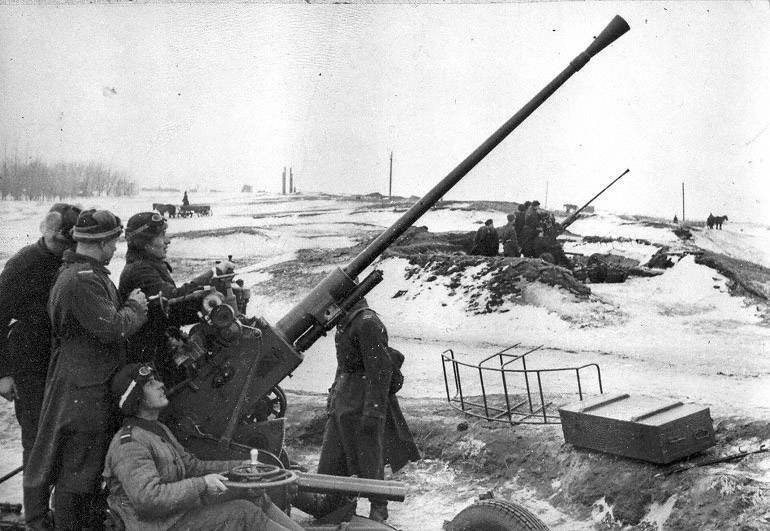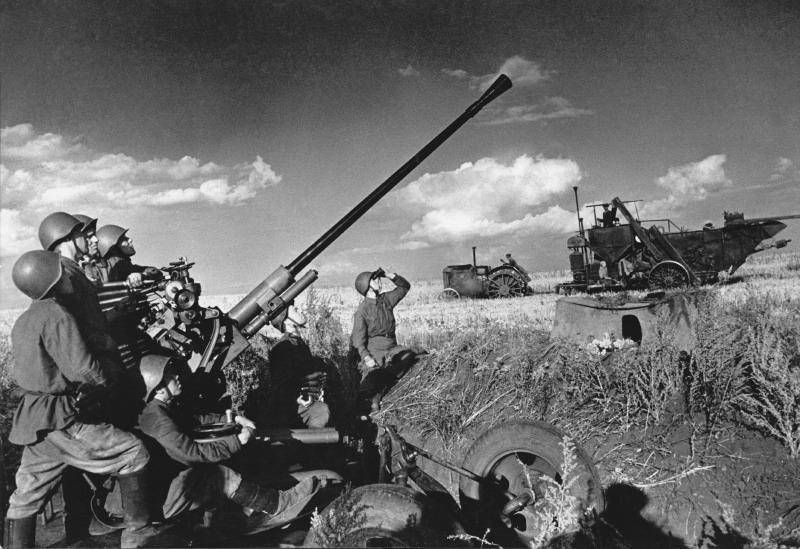Big war of small caliber

40 mm Bofors L60 automatic anti-aircraft guns on the guard of the "Road of Life".
In 1941–1945 small-caliber anti-aircraft artillery (MZA) played a large role in protecting the sky of the army and rear areas. On her account - a lot of downed enemy aircraft. At the front, the calculations of the MZA often - especially in the first years of the war - also had to engage in battles with enemy armored vehicles. These heroic episodes are described both in memoirs and in fiction. Covering the rear received quantitatively less attention, but it entered the storyline of the well-known film “The Dawns Here Are Quiet” - classics of Soviet cinema.
603th anti-aircraft artillery regiment
One of the parts of the MZA was the 603rd anti-aircraft artillery regiment.
In the General Staff reference book "The Combat Composition of the Soviet Army" he is mentioned from October 1, 1942 (date of formation) in the Moscow Military District, and from November 1 of the same year - on the Stalingrad Front. Then the mention of him disappears for a long time; perhaps the regiment was disbanded.
The next reference is found in stories regiment, published on the website "Memory of the People", and is dated January 22, 1944, when:
In total, the regiment had 60 guns - an impressive force comparable to a set of 37-mm guns in the state of the units tank army or anti-aircraft artillery division of the RVGK of four regiments!
Although in reality all 60 guns rarely covered a more or less compact area. Judging by the history of the regiment, they served for object air defense, being distributed by division or even by battery along some railway at stations, near bridges, etc.
It is worth noting that, according to Appendix No. 1 to the Decree of the GOKO No. 3660ss of June 29, 1943, the Bologoevsky air defense divisional area had 98 medium-caliber guns, 71 MZA guns and 143 anti-aircraft machine guns. It is unlikely that their number increased greatly over the next six months and, thus, most of the MZA guns that were available in the “mother” air defense divisional area were most likely transferred to the newly formed 603rd mzenap.
It is not clear what special role, along with the main armament of imported 40-mm machine guns, the Bofors L60 played in the new regiment of “makeweight” of several domestic 25-mm automatic guns of the 1940 model, creating unnecessary complexity for the supply and repairmen. Perhaps they just gave what they had.

37-mm automatic anti-aircraft gun 61-K.
The regiment consisted of a headquarters, service units and 5 line divisions of 3 batteries each. The batteries, obviously, were 4-gun composition. The number of the regiment in its history is omitted; it is only mentioned that it was formed according to state number 050/74.
Combat work
The regiment began combat work gradually, as divisions were formed:
Who was the enemy of the regiment? Of course the German aviation. But what exactly?
The time of large-scale air raids - like the bombing of Moscow, Leningrad and Gorky - has already passed, and small-caliber ones are not for "Uralbombers". By 1944, air supremacy had passed to Soviet aviation. And the Germans were forced to adopt the Soviet tactics of the first half of the war - harassing strikes at night.
Sometimes this brought success to the enemy, and for the reason that Sergeant Fedot Vaskov complained about in the film “The Dawns Here Are Quiet”. This reason is relaxation from the rear life. The history of the regiment says this:
Enemy aircraft were met by FORA fire and were not allowed to approach the objects. Particularly frequent and strong raids were observed in the areas of deployment of 1, 3, 4, 5 divisions.
On April 7, at 2:17, the enemy aircraft was allowed to approach the object of Art. Zhizhitsa, on the defense of which was the 3rd division (division commander Captain Fotin). As a result of the bombing, 24 wagons with food and ammunition going to the front were broken.
A preliminary investigation established that the bombing of the station with impunity occurred as a result of a criminal attitude to their official duties on the part of the division commander, Captain Fotin, and his battery commanders. At the time of the raid, the division did not fire. The officers on duty in the batteries sat out in dugouts. Most of the staff were asleep. No one was monitoring the air. The division commander himself, being an operational duty officer, slept at home, and instead of himself he put the artillery equipment of the division.
What happens next is very different from the movie. Probably no one even thought to replace the l / s with “non-drinking and non-smoking” anti-aircraft gunners. Instead of this:
Judging by the absence of an aircraft type in the description of the battle, the division not only did not have time to open fire, but could not even identify the attacking enemy!
In mid-April, the regiment changed positions.
The headquarters of the regiment moved to Staraya Russa, where the 1st division defended the bridge and the railway station. The 2nd division stood at the station. Views, 3rd and 4th divisions - at st. Bottom, 5th division - at the station. Myakovo. The 4th division was almost immediately redeployed to the railway bridges near the Parfino and Pola stations. And in early June, the 5th division was transferred to the railway stations Soltsy and Lemenka, and in its place - the battery of the 2nd division. As you can see, the positions of the regiment were again scattered at a considerable distance from each other.
During this period, episodes of the successful combat work of anti-aircraft gunners are interesting:
18.06.1944/1/215 5 Do-4 appeared at station. Myakovo. He was met with fire FOR the 01th battery, after which he retired and appeared at the station. Myakovo. 05th battery guarding st. Myakovo, fired. The enemy aircraft changed course and at 6:6 appeared at the station. Morino, guarded by the 352th battery. The XNUMXth battery fired. Total consumption - XNUMX shells. The aircraft failed to bomb.
June 18 is also marked by such a curious entry:
In July there was only one combat episode, with much more persistent and risky behavior of the German pilots:
In the registration book of the dead of the evacuation hospital No. 1853, the time of his injury is 00:30, and the time of death is 22:20.
Looking ahead, it is worth saying that Alexei Vasilyevich Ozhik, a very young fighter born in 1926, became the only combat loss of the regiment until the end of the war. Moreover, he was not listed as a calculation number, but as a shoemaker. Fate!..
A week later, the enemy again drew attention to Soltsy:
And on August 6th:
At the end of July, the regiment began to relocate to the west, closer to the front. The 2nd Division was the first to withdraw from the stations of Vzglya and Morino, leaving to defend the crossing across the Velikaya River and a certain railway junction (probably Pskov). Moreover, he left not by rail, but “under his own power”, that is, in vehicles that were on the staff of the regiment or temporarily attached to it.
On August 11, the headquarters of the regiment also left for Pskov. Combat work in the new place began almost immediately, and not only at night:
In September, the front went even further, and the divisions began to redeploy to Estonia.
In general, combat work has changed little, the batteries still from time to time repulsed harassing raids by single enemy aircraft.
The exception was September 16, when the enemy carried out a massive - relative to the forces of just one battery - attack on one of the objects:
Judging by the mention of "luminous aerial bombs", this large series of air raids took place at night, which indicates the competent coordination of actions and the good training of the German pilots.
There are no further recollections of combat episodes.
It seems that until the end of the war the regiment remained in the Baltic states, and the front line went further and further. There was a training of replenishment born in 1927, combat and political training, acceptance and delivery of materiel and other calm routine of rear service, to which the rest of the history of the regiment is devoted. The last mention of the regiment is found with reference to the Riga UR.
Сonclusion
Formally, the successes of the regiment were modest: not a single German aircraft was shot down or obviously damaged. Judging by the critical references in the railway department itself, with a better organization of the service and training of personnel, it would probably be possible to achieve better results in combat work.
On the other hand, in most combat episodes, anti-aircraft gunners prevented the enemy from reaching protected objects and prevented targeted bombing. So the regiment completely fulfilled its minimum program.
Information